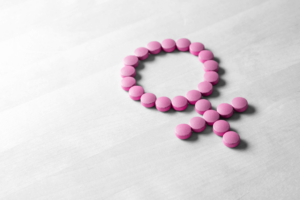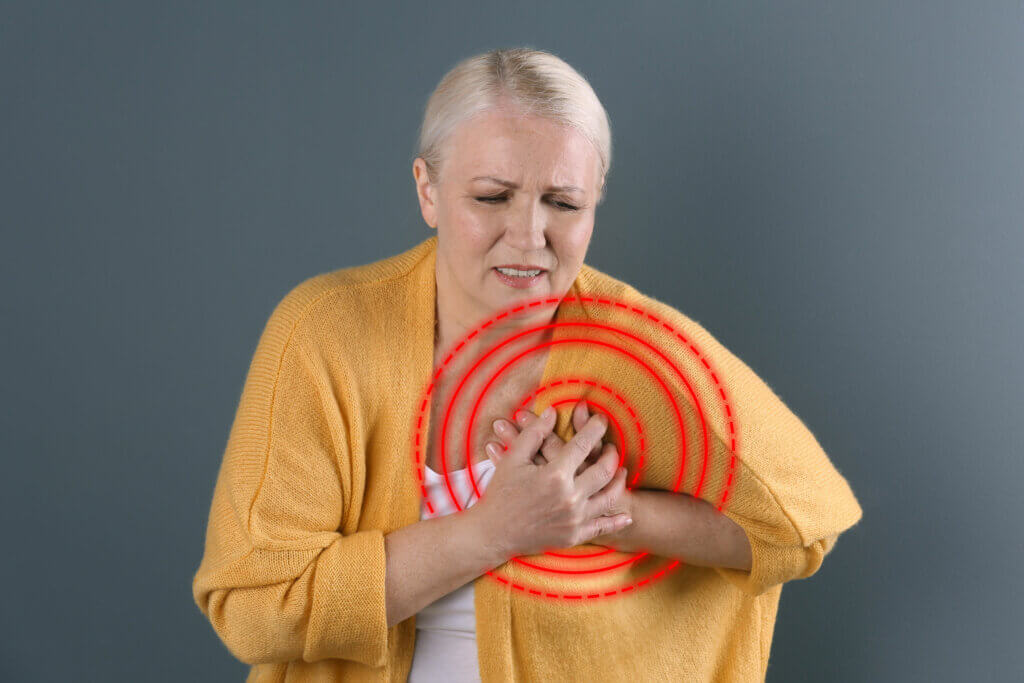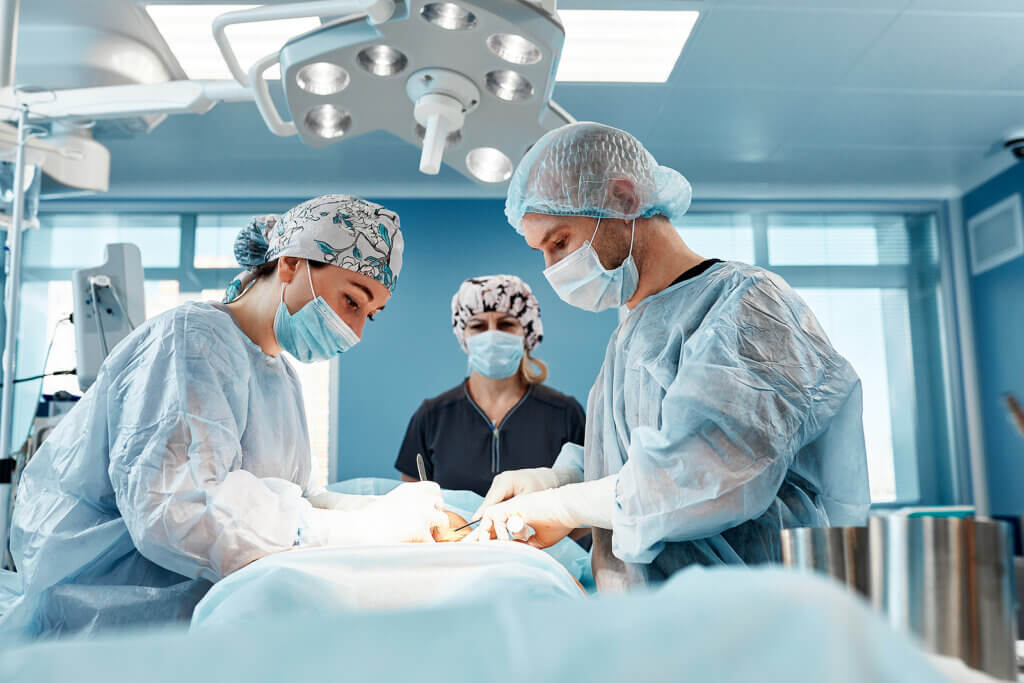Low Estrogen: Causes and Symptoms

Estrogens are sex hormones that give rise to female secondary sexual characteristics. They are secreted by the granular layer of the ovarian follicle, the corpus luteum, the placenta (during pregnancy), and the adrenal cortex. In the adrenal glands, part of the cholesterol is converted into androgens, and these in turn into these hormones. But what happens when we have low estrogen levels?
In the body, the main estrogen secreted by the ovary is estradiol. Other less active types are estrone, estriol, and estetrol. Any of them can reduce their concentration, although estradiol is the most studied and measured.
Physiology and functions of estrogens
In women, the hypothalamic-pituitary-ovarian axis regulates the secretion of female sex hormones. The hypothalamus secretes gonadotropin-releasing hormone (GnRH), which stimulates the secretion of follicle-stimulating hormone (FSH) and luteinizing hormone (LH).
These pituitary hormones stimulate the ovary to produce estrogen and progesterone. Elevated estrogen levels, in turn, inhibit FSH secretion to maintain an adequate level in the blood, according to the phase of the menstrual cycle.
Estrogens act on different systems, but mainly on the reproductive system of women. Its effects are as follows:
- Breasts: They stimulate the development of glandular breast tissue during female puberty and the development of breast ducts during pregnancy.
- Uterus: They promote the growth and vascularization of the endometrium.
- Vaginal area: Estrogens favor the proliferation of epithelial cells that line the vaginal walls and vulva.
- Rest of the genital tract: They help the development of follicles, increase cervical mucus making it more fluid, and increase the motility of the fallopian tubes.
- Female characteristics: Fat deposits in breasts and buttocks, more hair, triangular pubic hair.
- Contraception: Both natural estrogens and oral contraceptives inhibit the secretion of GnRH and FSH.
- Bones: Estrogens determine the pubertal growth spurt and participate in the development of long bones and fusion of the epiphyseal growth plates. They also inactivate the osteoclasts, that is, they reduce the removal of calcium from the bones, with a lower risk of osteoporosis.
- Cardiovascular: They reduce the risk of developing cardiovascular diseases by increasing high-density lipoproteins (HDL) or good cholesterol.
- Coagulation: Certain coagulation factors (I, V, VIII and IX), fibrinogen formation, and platelet activity increase.

What symptoms does low estrogen produce?
Low estrogen, whatever the cause, affects the reproductive system and the quality of life of women in general. Symptoms can vary, depending on the specific disorder causing the deficit.
There are symptoms directly associated with hypoestrogenism and others that are secondary. We can summarize them in the following list:
- Alterations in the menstrual cycle
- Vaginal dryness leading to painful intercourse
- Infertility
- Osteoporosis due to decreased bone density
- Sudden and intense heat sensation (hot flashes)
- Fatigue
- Emotional changes
- Difficulty focusing
- Recurrent urinary infections
Causes of low estrogen
The causes of low estrogen are many. We can divide them into physiological and pathological. The former are related to menopause, that is, with the regression of the ovaries, which, in turn, reduces the natural production of estrogens.
Among the pathological causes, the most relevant are those that we will deal with below.
Hyperprolactinemia
The most common cause of hyperprolactinemia is prolactinoma, a prolactin-producing tumor of the pituitary. Symptoms are unilateral or bilateral milk discharge from the nipple, spontaneous or caused manually, and not related to pregnancy.
Functional hypothalamic amenorrhea
This is a form of chronic anovulation (absence of ovulation), due to decreased GnRH secretion, but without an identifiable organic cause. Exogenous GnRH administration can correct this condition.
Kallmann syndrome
This disorder is a genetic defect resulting from the interruption of the embryonic migration of the cells that will give rise to the neurons that synthesize GnRH. It’s usually more common in men than in women.
Patients present with anosmia or hyposmia (absence or decreased sense of smell) and altered sexual characteristics. In men, the testicular volume is reduced and they suffer from erectile dysfunction.
Anorexia
Anorexia is defined as a lack of appetite due to an intense fear of gaining weight, due to an alteration in body image. There is a loss of body weight by height (greater than 15%) and amenorrhea (absence of menstruation) for at least 3 months.
Menstrual changes in anorexia are produced by alteration of the hypothalamus with decreased secretion of GnRH, which, in turn, decreases blood levels of LH. In the long run, there’s a decrease in progesterone, testosterone, androstenedione, and estrogens.
In addition to menstrual alterations, anorexia can cause dermatological changes due to vitamin deficiency (lanugo hair), hematological (anemia), kidney (low potassium) and cardiovascular changes (hypotension, arrhythmias).
Excessive exercise
As in the previous case, there are changes in the hypothalamus, a decrease in GnRH, and a consequent reduction in estrogens. Women who exercise excessively suffer changes in the development of female sexual characteristics, amenorrhea, and infertility.
Primary ovarian failure (POI)
This estrogen deficit occurs in women under 40 years of age and has a varied etiology. Among them, having insufficient or dysfunctional ovarian follicles at birth.
It’s important to realize that women with POI don’t always stop menstruating and their ovaries don’t always stop working completely. Because of this, they can sometimes get pregnant.
Turner syndrome
Turner syndrome is a genetic disorder characterized by the absence of the X chromosome in women (X0). Physical changes such as short stature, short neck, low set of ears, cleft palate, and a small jaw can be observed. It is accompanied by amenorrhea and delayed sexual development.
Iatrogenic
If patients undergo surgery (oophorectomy or pituitary resection, for example), chemotherapy, or radiation therapy that affects the hypothalamic-pituitary-genital axis, they may develop prematurely low estrogens, not associated with menopause.

How to improve the symptoms of hypoestrogenism?
Symptoms caused by low estrogen can be improved with hormone replacement therapy that involves the administration of exogenous estrogens in the form of pills, patches, and injections. However, before starting, the patient should be carefully evaluated.
Consider whether you are at risk of developing breast or endometrial cancer, as well as your cardiovascular profile, as exogenous estrogens can increase the risk of developing these pathologies. The risk/benefit balance of this therapy is specific to each person.
Estrogens are sex hormones that give rise to female secondary sexual characteristics. They are secreted by the granular layer of the ovarian follicle, the corpus luteum, the placenta (during pregnancy), and the adrenal cortex. In the adrenal glands, part of the cholesterol is converted into androgens, and these in turn into these hormones. But what happens when we have low estrogen levels?
In the body, the main estrogen secreted by the ovary is estradiol. Other less active types are estrone, estriol, and estetrol. Any of them can reduce their concentration, although estradiol is the most studied and measured.
Physiology and functions of estrogens
In women, the hypothalamic-pituitary-ovarian axis regulates the secretion of female sex hormones. The hypothalamus secretes gonadotropin-releasing hormone (GnRH), which stimulates the secretion of follicle-stimulating hormone (FSH) and luteinizing hormone (LH).
These pituitary hormones stimulate the ovary to produce estrogen and progesterone. Elevated estrogen levels, in turn, inhibit FSH secretion to maintain an adequate level in the blood, according to the phase of the menstrual cycle.
Estrogens act on different systems, but mainly on the reproductive system of women. Its effects are as follows:
- Breasts: They stimulate the development of glandular breast tissue during female puberty and the development of breast ducts during pregnancy.
- Uterus: They promote the growth and vascularization of the endometrium.
- Vaginal area: Estrogens favor the proliferation of epithelial cells that line the vaginal walls and vulva.
- Rest of the genital tract: They help the development of follicles, increase cervical mucus making it more fluid, and increase the motility of the fallopian tubes.
- Female characteristics: Fat deposits in breasts and buttocks, more hair, triangular pubic hair.
- Contraception: Both natural estrogens and oral contraceptives inhibit the secretion of GnRH and FSH.
- Bones: Estrogens determine the pubertal growth spurt and participate in the development of long bones and fusion of the epiphyseal growth plates. They also inactivate the osteoclasts, that is, they reduce the removal of calcium from the bones, with a lower risk of osteoporosis.
- Cardiovascular: They reduce the risk of developing cardiovascular diseases by increasing high-density lipoproteins (HDL) or good cholesterol.
- Coagulation: Certain coagulation factors (I, V, VIII and IX), fibrinogen formation, and platelet activity increase.

What symptoms does low estrogen produce?
Low estrogen, whatever the cause, affects the reproductive system and the quality of life of women in general. Symptoms can vary, depending on the specific disorder causing the deficit.
There are symptoms directly associated with hypoestrogenism and others that are secondary. We can summarize them in the following list:
- Alterations in the menstrual cycle
- Vaginal dryness leading to painful intercourse
- Infertility
- Osteoporosis due to decreased bone density
- Sudden and intense heat sensation (hot flashes)
- Fatigue
- Emotional changes
- Difficulty focusing
- Recurrent urinary infections
Causes of low estrogen
The causes of low estrogen are many. We can divide them into physiological and pathological. The former are related to menopause, that is, with the regression of the ovaries, which, in turn, reduces the natural production of estrogens.
Among the pathological causes, the most relevant are those that we will deal with below.
Hyperprolactinemia
The most common cause of hyperprolactinemia is prolactinoma, a prolactin-producing tumor of the pituitary. Symptoms are unilateral or bilateral milk discharge from the nipple, spontaneous or caused manually, and not related to pregnancy.
Functional hypothalamic amenorrhea
This is a form of chronic anovulation (absence of ovulation), due to decreased GnRH secretion, but without an identifiable organic cause. Exogenous GnRH administration can correct this condition.
Kallmann syndrome
This disorder is a genetic defect resulting from the interruption of the embryonic migration of the cells that will give rise to the neurons that synthesize GnRH. It’s usually more common in men than in women.
Patients present with anosmia or hyposmia (absence or decreased sense of smell) and altered sexual characteristics. In men, the testicular volume is reduced and they suffer from erectile dysfunction.
Anorexia
Anorexia is defined as a lack of appetite due to an intense fear of gaining weight, due to an alteration in body image. There is a loss of body weight by height (greater than 15%) and amenorrhea (absence of menstruation) for at least 3 months.
Menstrual changes in anorexia are produced by alteration of the hypothalamus with decreased secretion of GnRH, which, in turn, decreases blood levels of LH. In the long run, there’s a decrease in progesterone, testosterone, androstenedione, and estrogens.
In addition to menstrual alterations, anorexia can cause dermatological changes due to vitamin deficiency (lanugo hair), hematological (anemia), kidney (low potassium) and cardiovascular changes (hypotension, arrhythmias).
Excessive exercise
As in the previous case, there are changes in the hypothalamus, a decrease in GnRH, and a consequent reduction in estrogens. Women who exercise excessively suffer changes in the development of female sexual characteristics, amenorrhea, and infertility.
Primary ovarian failure (POI)
This estrogen deficit occurs in women under 40 years of age and has a varied etiology. Among them, having insufficient or dysfunctional ovarian follicles at birth.
It’s important to realize that women with POI don’t always stop menstruating and their ovaries don’t always stop working completely. Because of this, they can sometimes get pregnant.
Turner syndrome
Turner syndrome is a genetic disorder characterized by the absence of the X chromosome in women (X0). Physical changes such as short stature, short neck, low set of ears, cleft palate, and a small jaw can be observed. It is accompanied by amenorrhea and delayed sexual development.
Iatrogenic
If patients undergo surgery (oophorectomy or pituitary resection, for example), chemotherapy, or radiation therapy that affects the hypothalamic-pituitary-genital axis, they may develop prematurely low estrogens, not associated with menopause.

How to improve the symptoms of hypoestrogenism?
Symptoms caused by low estrogen can be improved with hormone replacement therapy that involves the administration of exogenous estrogens in the form of pills, patches, and injections. However, before starting, the patient should be carefully evaluated.
Consider whether you are at risk of developing breast or endometrial cancer, as well as your cardiovascular profile, as exogenous estrogens can increase the risk of developing these pathologies. The risk/benefit balance of this therapy is specific to each person.
- Delgado B, Lopez-Ojeda W. Estrogen. StatPearls [Internet]. [Última actualización: abril, 2021; citado: julio 2021]. Disponible en: https://www.ncbi.nlm.nih.gov/books/NBK538260/
- Nass R et al. Physiological and Pathophysiological Alterations of the Neuroendocrine Components of the Reproductive Axis. Yen & Jaffe’s Reproductive Endocrinology (Seventh Edition). 2014: 13; 439-484. doi: https://doi.org/10.1016/B978-1-4557-2758-2.00021-4
- Meczekalski B, Podfigurna-Stopa A, Genazzani AR. Hypoestrogenism in young women and its influence on bone mass density. Gynecol Endocrinol. 2010 Sep;26(9):652-7. doi: 10.3109/09513590.2010.486452. PMID: 20504098.
- Sociedad Argentina de Ginecología Infanto-juvenil. Amenorrea hipotalámica funcional: Guía de práctica clínica. J Clin Endocrinol Metab 2017 May; 102(5):1413-1439
- Cabrejas MC, et al. Síndrome de Kallmann de diagnóstico tardío. Endocrinología y Nutrición Elsevier. 2015; 62 (2): 106-108. DOI: 10.1016/j.endonu.2014.10.002
- Pikerton J. Fallo ovárico primario. Manual MSD [Internet]. [Última actualización: Dic 2020; citado: jul 2021]. Disponible en: https://www.msdmanuals.com/es-ve/professional/ginecolog%C3%ADa-y-obstetricia/anomal%C3%ADas-menstruales/fallo-ov%C3%A1rico-primario
- Karen O Klein, et al. Estrogen Replacement in Turner Syndrome: Literature Review and Practical Considerations. J Clin Endocrinol Metab. 2018; 103 (5): 1790-1803, https://doi.org/10.1210/jc.2017-02183
Este texto se ofrece únicamente con propósitos informativos y no reemplaza la consulta con un profesional. Ante dudas, consulta a tu especialista.







